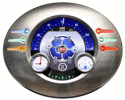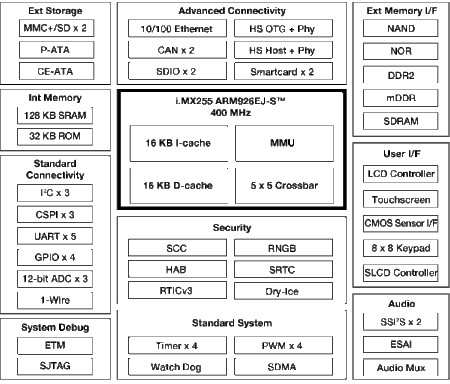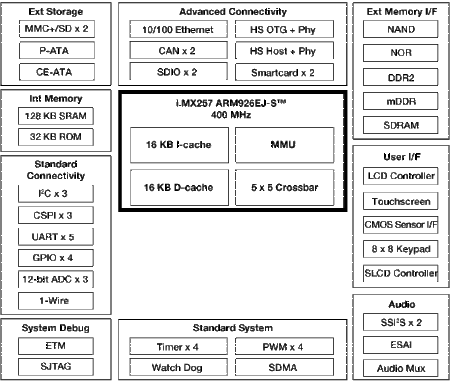ARM9 SoC targets touch-capable auto and industrial devices
Jun 17, 2009 — by Eric Brown — from the LinuxDevices Archive — 10 views Freescale launched an “i.MX25” family of system-on-chips (SoCs) targeting automotive infotainment (i.MX251 and i.MX255) and industrial applications (i.MX253, i.MX257, and i.MX258). Based on a 400MHz ARM926EJ-S core, and supported by a hardware/software development kit (pictured), most of the SoCs support LCDs,… touchscreens, and security features.
Freescale launched an “i.MX25” family of system-on-chips (SoCs) targeting automotive infotainment (i.MX251 and i.MX255) and industrial applications (i.MX253, i.MX257, and i.MX258). Based on a 400MHz ARM926EJ-S core, and supported by a hardware/software development kit (pictured), most of the SoCs support LCDs,… touchscreens, and security features.
The i.MX25 family is the first of Freescale Semiconductor's applications processors that integrate LCD and touchscreen controllers, DDR2 memory support, controller area network (CAN), Ethernet, and USB connectivity in one package, according to the company. As a result of this on-chip integration, the need for discrete components is reduced, decreasing cost and required board space, says Freescale.
Like Freescale's i.MX27 SoC and earlier i.MX21, both of which are primarily aimed at portable media players (PMPs) and other handheld devices, the i.MX25 incorporates an ARM926EJ-S core clocked at 400MHz. While the i.MX27 added on-chip video acceleration, more storage interfaces, and a 10/100 Ethernet port to the i.MX21 design, the new i.MX25 SoCs focus on features common to both automotive and industrial settings, such as CAN bus support.
Freescale says the i.MX25 products provide a full mix of I/O interfaces for industrial settings, while also supplying the LCD touchscreen support that is often required in both automotive infotainment and industrial HMI devices. The i.MX25 SoCs support up to SVGA (800 x 600) resolution, but lack the i.MX27's advanced video acceleration for D1 video.
All five of the i.MX25 devices offer integrated 10/100 Ethernet, USB 2.0 with PHY, A/D converters, as well as standard UART, I2C, and SPI ports. The common memory interface controller supports a wide variety of memory types, including DDR2, says the company. The SoCs are claimed to be “low-power” processors, and are naturally capable of battery-powered operation, but power consumption figures do not appear to be available.
 Yazaki Instrumentation Cluster (Click for details) |
Freescale also offers higher end ARM11-based i.MX353 and i.MX357 SoCs, targeting the automotive market. In addition, it manufactures the telematics focused, PowerPC-based MPC5121e SoC, which is being incorporated in a new automotive gauge cluster from Yazaki (pictured at right). Freescale recently joined the Genivi Alliance for standardizing certain aspects of automotive infotainment systems.

i.MX255 (high-end automotive infotainment) block diagram
(Click to enlarge)
The i.MX25 portfolio includes the following versions:
- i.MX251 — This entry level automotive infotainment system is targeted primarily at audio-driven systems. It is said to have achieved full AECQ-100 automotive qualification.
- i.MX255 — Building on the automotive i.MX251 feature set, the i.MX255 is aimed at full-fledged infotainment systems, adding an LCD controller, resistive touchscreen controller, and a PATA/CE-ATA storage interface (see block diagram above). The SoC is said to connect directly to high-resolution displays (up to SVGA) at high color depth (up to 18bpp), and supports video input.
- MX253 — Designed for industrial and general embedded applications, this entry level SoC offers multiple connectivity options and an LCD controller. Applications include residential smart meters, graphical keypads and security panels, human machine interface (HMI) designs, barcode scanners, factory automation and robotics, and printers, says Freescale.
- i.MX257 — This higher end i.MX257 industrial SoC (see diagram below) builds upon the i.MX253 feature set with a resistive touch screen controller, camera sensor interface, two smartcard interfaces, two CAN interfaces, and an ESAI interface for audio applications, says the company.
- i.MX258 — Offering all the features of the i.MX257, the i.MX258 is designed for the industrial security market, as well as point-of-sale (POS) systems. Featuring an on-chip security engine, it offers “highly specific” tamper detection circuitry that is said to quickly erase confidential information if a threat is detected.

i.MX257 (high-end industrial, but without security) block diagram
(Click to enlarge)
Specifications listed for the i.MX25 family (with exceptions noted for particular versions), include:
- Core — ARM926EJ-S @ 400MHz with 16K I/D L1 cache
- On-chip memory — 128KB SRAM; 32KB ROM
- External memory support — DDR2, mDDR, SDRAM, mSDRAM, NOR, SLC/MLC NAND
- Storage — PATA/CE-ATA (except i.MX251); 2 x SD/SDIO/MMC
- Display — LCD controller (except i.MX251); touchscreen support (except i.MX251 and i.MX253)
- Networking — 10/100 Ethernet MAC
- USB — High-speed (480Mbps) USB 2.0 OTG+PHY and Host+PHY
- Basic I/O:
- 3 x I2C
- 2 x SSI/I2S
- 3 x CSPI
- 5 x UART
- 3 x 12-bit ADC
- 3.3V General Purpose I/O
- Specialty I/O (except i.MX253):
- 1 x CMOS sensor interface (CSI)
- 2 x FlexCan Controllers (CAN bus)
- 1 x ESAI (audio)
- 2 x Smartcard
- Security — Security engine available (except i.MX253 and i.MX257)
- Package — 17×17 MAPBGA 0.8mm
- Temperature — -40 to 185 deg. F (-40 to 85 deg. C) standard for i.MX251, i.MX255, and i.MX258, and optional for i.MX253 and i.MX257, which come standard with -20 to 158 deg. F (-20 to 70 deg. C).
- Operating system — PDK available for Linux and Windows CE
i.MX25 PDK
As with other recent i.MX-family processors, Freescale is offering a multi-board PDK and software development kit (SDK) for the i.MX25 family. In this case, however, the PDK appears to be arriving in conjunction with the SoCs themselves, rather than appearing later.

i.MX25 PDK
(Click to enlarge)
The PDK ships with “comprehensive board support” for Linux and Windows CE, enabling rapid prototyping, says Freescale. The BSPs are said to include “consistent” application programming interfaces (APIs) and frameworks, as well as development tools, test streams, and documentation.
As with other Freescale i.MX PDKs, the i.MX25 PDK hardware includes three interconnecting modules: processor, personality, and debug. The personality module is equipped with a 5.7-inch TFT VGA touchscreen display, an SD card, an Ethernet port, two USB ports, a CAN connector, a CMOS sensor, and audio I/O. The PDK also comes with a power source and current/power monitoring.
The following features are listed for the i.MX25 PDK hardware:
- Processor Module:
- i.MX25 with ARM926EJ-S core
- Freescale MC34704B power management IC
- Freescale SGTL5000 ultra low-power audio codec
- 64MB or 512MB DDR2
- 2GB NAND flash
- Personality Module:
- Programmable user I/O
- 5.7-inch TFT VGA with touchscreen
- CMOS image sensor
- U/I connector to support other LCD panels (with or without touchscreen)
- Audio input connectors
- Headphone jack
- CAN connector
- 2 x USB 2.0 ports
- 10/100 Ethernet port
- SD card for WiFi or external data storage
- Debug Module:
- Debug Ethernet port
- Debug serial port
- JTAG
- Reset, interrupt, boot switches
- Debug LEDs
Early Software support
Testimonial quotes were offered from a variety of software vendors supporting the i.MX25, with the two that mentioned specific Linux support (AllGo and CodeSourcery) listed below. The full list of vendors announcing support include Adeneo Embedded, AllGo Embedded Systems, Beckoff, CodeSourcery, IAR Systems, ICytecture, Ka-Ro Electronics, and QNX.
Stated Paul Marino, GM of Freescale's Multimedia Applications Division, “Freescale designed the i.MX25 family to help embedded designers reduce the cost of adding connectivity, touchscreen, DDR2 memory and security features to their applications.”
Stated K. Srinivasan, CEO of AllGo Embedded Systems, “The i.MX25 processors provide an ideal migration path for customers using the MCF5251 processor and Trio software suite. The Linux OS-based Multimedia Automotive Reference Software (MARS) being developed by AllGo on i.MX25 drastically reduces the development time for infotainment products.”
Stated Mark Mitchell, chief sourcerer of CodeSourcery, “We're pleased that Freescale is recommending Sourcery G++ for GNU/Linux development on i.MX25 processors, as well as the rest of the i.MX product line.”
Availability
The i.MX25 applications processors are now in production, with suggested resale pricing in 10,000-unit quantities ranging from $6.96 to $9.73, depending on the device. The Product Development Kit (PDK) based on the i.MX25 processor, for both Linux and Windows Embedded CE, is offered at $1,000.
More information on the i.MX25 family may be found here, and more on the PDK should be here.
This article was originally published on LinuxDevices.com and has been donated to the open source community by QuinStreet Inc. Please visit LinuxToday.com for up-to-date news and articles about Linux and open source.